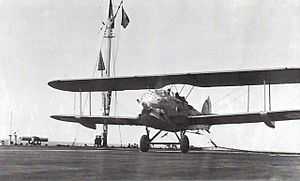Levasseur PL.4
| PL.4 |
|---|
 |
| Deck landing of a Levasseur PL-4 |
| Role |
Carrier-based reconnaissance aircraft |
| National origin |
France |
| Manufacturer |
Levasseur |
| First flight |
1926 |
| Primary user |
Aéronavale |
| Number built |
40 |
|
|
The Levasseur PL.4 was a carrier-based reconnaissance aircraft produced in France in the 1920s. It was a conventional, single-bay biplane that carried a crew of three in tandem, open cockpits. Purchased by the Aéronavale to operate from the aircraft carrier Béarn, it incorporated several safety features in case of ditching at sea. Apart from small floats attached directly to the undersides of the lower wing, the main units of the fixed, tailskid undercarriage could be jettisoned in flight, and the underside of the fuselage was given a boat-like shape and made watertight.
Operators
-
 France
France
Specifications
General characteristics
- Crew: Three
- Length: 9.67 m (31 ft 9 in)
- Wingspan: 14.60 m (47 ft 11 in)
- Height: 3.85 m (12 ft 8 in)
- Wing area: 61.0 m2 (656 ft2)
- Empty weight: 1,690 kg (3,720 lb)
- Gross weight: 2,640 kg (5,810 lb)
- Powerplant: 1 × Lorraine-Dietrich 12Eb, 335 kW (450 hp)
Performance
- Maximum speed: 178 km/h (111 mph)
- Range: 900 km (560 miles)
- Service ceiling: 5,000 m (16,400 ft)
See also
- Related lists
References
|
|---|
| | General | |
|---|
| | Military | |
|---|
| | Accidents / incidents | |
|---|
| | Records | |
|---|
| | Misc. | |
|---|
|
